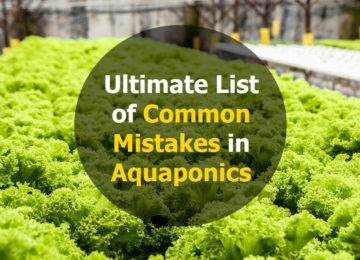Crayfish certainly add a new inexpensive dimension to your aquaponics system. It is amusing to see them climbing up a plant, trying to jump and doing similar crazy stuff in the tank. You can farm the native species for fish bait, stocking ponds, and great ornamental prices at the local aquarium hobby shop. They also assist in breaking down the uneaten feed and fish waste. The most commonly raised are the red swamp crayfish (Procambarus Clarkii), red claw crayfish (Cherax) and the white crayfish (Procambarus Acutus).
If you are farming shrimps already in your pond or backyard, then you definitely should consider integrating aquaponics. It will help to improve the water quality and providing you with another crop (veggies from plants).
If its other way around or you’re thinking of starting an aquaponics using crayfish. Then you should understand several limitations to raise them in an aquaponics system. Usually, an aquaponics system designed for cultivating fish is unsuitable to house the freshwater crayfish. They also don’t provide a good value as food harvests. Most of the species don’t reach a large enough size for commercial production. Let’s take deeper insights on several such factors.
Table of Contents
Stocking Densities
Crayfish live in the benthic/bottom zone which makes ponds and tanks largely under-utilized. being a benthic recycler, they can attack any dying or ill fish as they do in their natural ecosystem.
You’ll probably run out of square ft. before you overload your biofilter since they need a lot of space.
A pregnant female crayfish holds about 1 berry per 1 gram of body weight producing 100s of the little crayfish. The eggs of red claw crayfish hatch in 30 days in the water temperatures of above 75°F (24 °C).
It is really important to provide complex hides for the crayfish and roughly three times the amount of crayfish you plan to have. You can keep about 8-10 crayfish per square meter in the aquarium having plenty of hideous places.
Red claw females generally produce from 100 to 1000 juveniles per female with higher survival rates because they do not have larval stages.
Tank Mates
Since you have learned that crayfish need a lot of space and only cover the benthic part of an aquarium. It is not advisable to run an aquaponics system solely on crayfish. To make it efficient, you may want to add some aquaponics fish with your benthos crayfish. There are many limitations to do so.
Fish can attack and eat young crayfish. Anglers use them as bait to catch fish! However, Many aquaponics hobbyists usually keep crayfish with catfish or perch when they are too big for fish to swallow.
In some cases, it can be totally opposite. If you have small fish like bettas, ryukin goldfish, swordtails, gouramis, and rainbow shark, you can end up getting your fish eaten by crayfish.
However, Australian red claw crayfish are kept with Nile tilapia in certain conditions. The research shows that growth, reproduction and food conversion of tilapia were adversely affected by the presence of crayfish.
Check out this video to learn more.
Feed Habits
Crayfish are omnivorous. They not only eat plant matter and detritus but also hunt snails, mussels, leeches, worms, and will eat each other on occasion. Although crayfish normally are not able to catch healthy fish, the injured, sick or dead fish and amphibians are a welcome treat for them.
In the aquarium, you can feed them any kind of vegetable and dried foods, such as flakes, wafers, and tablets. Some crayfish like red claw does not undergo larval stages like other freshwater shrimp. They can eat a pelleted diet after being released from the female. Red claw also has less cannibalistic nature if shelters are provided that make them easier for a producer to establish his own hatchery.
Water Quality
The water quality requirements and optimum temperature range vary greatly among different crayfish species. Generally, they need dechlorinated water between 80 degrees and 90 degrees Fahrenheit.
They grow better in water with higher pH of 7.2 to 8.2; although many species can thrive a range of 6.5 to 8.0 according to research literature. The most plants are able to absorb more beneficial nutrients and grow better in pH range between 5.5 and 7.0. So you have to optimize pH to a very narrow range to get maximum efficiency.
Nitrogen spikes, chlorinated water, or poorly monitored water additions can easily kill crayfish. You need to make sure that biological filtration (aquaponic system) has enough potential to deal with ammonia or nitrite (waste byproducts). Crayfish suffering from ammonia or nitrite toxicity suddenly become lifeless with little limb movement.
Most aquaponist keeps them with goldfish, catfish or tilapia which are relatively hardy as compared to crayfish. Since the system is taken care of according to the fish requirements, most of the crayfish end up dying within the first 3 weeks. You need frequent water testing to ensure that ammonia and nitrite levels are at acceptable concentrations.
The good aeration and water circulation are critical for crayfish. They essentially require to climb out of the water if the water is not aerated or filtered.
Regulations
In most areas, crayfish are subject to government laws that regulate what species, how many, and where they can be harvested legally. You may also require a state fishing license to harvest crayfish. The use of crayfish as fish bait and the introduction of crayfish into natural lakes or streams are illegal in some states.
The importation and transport of crayfish are also regulated to limit the introduction of non-native species which can eliminate native crayfish and fish. Like, Red Swamp Crayfish is considered invasive species and prohibited in Michigan.

